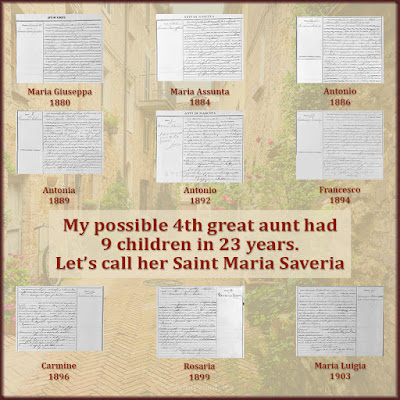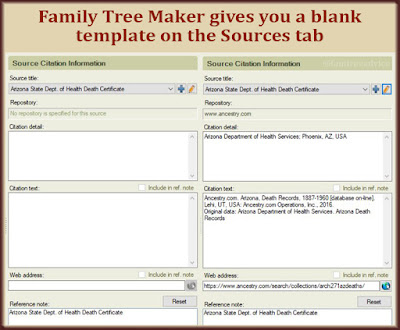What can I do to find my closest unidentified ancestor?
It bothers me that I'm missing the name of only 1 of my 32 3rd great grandparents. It's amazing to have that column of
my grandparent chart all filled in. But one of the spaces says "mother of Maria Luigia Muollo"—my 2nd great grandmother.
Come along with me as I try to find her.
My Muollo family comes from a tiny little hamlet called Pastene—part of a small town in southern Italy. Because the town is so small, it seemed to fly under the radar. It didn't start collecting civil records in 1809 like the rest of Italy.
- 1861–1915 birth records
- 1931–1942 death records
- 1931–1942 marriage records
Those gaps in the record collection are enough to make me cry. I even
hired a pair of Italian genealogists to go to the local church for records. What they found was wonderful. But they also discovered a huge lack of records.
I know that my 2nd great grandmother's father was Antonio Muollo. He was born in about 1818. I don't know when he died.
I've been piecing together families from the records I have. I've found only one other Muollo who's father is an Antonio. Maria Saveria Muollo was born in 1859.
Could she be my 2nd great grandmother's younger sister? There's a 16-year age difference between them. That's common in Italian families of the 19th century. And my Antonio was only about 41 when Maria Saveria was born. I know that Maria Saveria married Orazio Sarracino.
This is a TINY town. My 2nd great grandparents were Maria Luigia Muollo and Giuseppe Sarracino. If this theory pans out, the 2 Muollo sisters each married a Sarracino.
How can I prove Maria Saveria's relationship to my 2nd great grandmother, Maria Luigia?
The first step is always to gather as many documents and pieces of evidence as you can about the person. Let's see what I can learn about Maria Saveria Muollo.
 |
| To find more clues about Maria Saveria, I gathered the birth records for her children. |
Birth Records
I have the Pastene birth records for Maria Saveria's 9 children with Orazio Sarracino:
- Maria Giuseppa, 1880
- Maria Assunta, 1884
- Antonio, 1886 (who must have died before 1892)
- Antonia, 1889
- Antonio, 1892
- Francesco, 1894
- Carmine, 1896
- Rosaria, 1899
- Maria Luigia, 1903
The last birth record, dated 24 November 1903, says Orazio was not present. He was domiciliato all'estero—living abroad. Sure enough, I found Orazio's 1903 ship manifest.
Immigration Records
Orazio and his daughter Maria Assunta left for New York THREE DAYS before his 9th child was born. I already can't stand this guy. Ships left for New York often. He had to leave when his wife was 9 months pregnant? Sheesh.
Orazio never sent for his wife to join him. Maybe he planned to return to Italy. Maybe he did return to Italy. Orazio died between 1910 and 1920. I don't know where.
In 1920, Maria Saveria and her 2 youngest daughters boarded a ship. They went to the Bronx to join her son Francesco. I like to think of her saying, "Who needs you? I'm going to America anyway."
 |
| This lady made that difficult voyage to America at 61 years of age. |
Census Records
Back in the 1910 U.S. census, Orazio and his son Antonio are living in the Bronx. They're in the home of Orazio's eldest daughter Maria Giuseppa and her husband.
In the 1915 New York State Census, Antonio Sarracino is still living in the Bronx. He is married and has one child. His father is not with him.
In the 1940 U.S. census, Maria Saveria is 80 years old. She's living with her daughter Rosaria and Rosaria's family. It's amazing to find her at age 80. I would guess she didn't live a whole lot longer.
Death Records
One death record shows up on Ancestry.com that's promising. If it's Maria Saveria, she died in the Bronx in 1944 at age 84. The same record on FamilySearch.org offers more information. It says that her husband was Orazio Sarracino and her father was Antonio Muollo. It's her, alright.
But it also has the most important piece of information I'd been hoping to find: her mother's name. There it is.
Is Giuseppina Torrico my 3rd great grandmother? Is she the only 3rd great grandparent whose name I'm missing?
A check of the vital records in Pastene shows no one with that last name. Was it transcribed incorrectly because it was hard to read? What names do I have from the town that are close?
 |
| I can't accept a stranger's transcription blindly. That is not quite the right name. |
My best guess, without seeing the actual death certificate, is that her last name was Errico. Maybe the E was all fancy and hard to read. Errico is a fairly common name in Pastene. There used to be a neighborhood with that name in the 1860s.
After all that research, I'm left with a theory. A stronger theory than I had before. I'm still missing marriage and death certificates from Pastene, so I can't prove anything.
But perhaps—just perhaps—Maria Saveria Muollo is the younger sister of my 2nd great grandmother. And perhaps Giuseppina Errico is my missing 3rd great grandmother.
It's a good enough theory to record in my family tree.
















